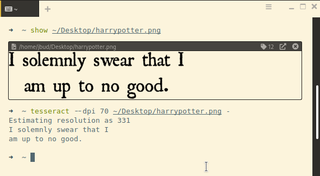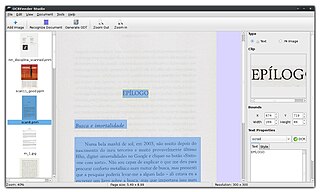
A quine is a computer program that takes no input and produces a copy of its own source code as its only output. The standard terms for these programs in the computability theory and computer science literature are "self-replicating programs", "self-reproducing programs", and "self-copying programs".

The Netwide Assembler (NASM) is an assembler and disassembler for the Intel x86 architecture. It can be used to write 16-bit, 32-bit (IA-32) and 64-bit (x86-64) programs. It is considered one of the most popular assemblers for Linux and x86 chips.

Typesetting is the composition of text for publication, display, or distribution by means of arranging physical type in mechanical systems or glyphs in digital systems representing characters. Stored types are retrieved and ordered according to a language's orthography for visual display. Typesetting requires one or more fonts. One significant effect of typesetting was that authorship of works could be spotted more easily, making it difficult for copiers who have not gained permission.
OpenEXR is a high-dynamic range, multi-channel raster file format, released as an open standard along with a set of software tools created by Industrial Light & Magic (ILM), under a free software license similar to the BSD license.

The device independent file format (DVI) is the output file format of the TeX typesetting program, designed by David R. Fuchs and implemented by Donald E. Knuth in 1982. Unlike the TeX markup files used to generate them, DVI files are not intended to be human-readable; they consist of binary data describing the visual layout of a document in a manner not reliant on any specific image format, display hardware or printer. DVI files are typically used as input to a second program which translates DVI files to graphical data. For example, most TeX software packages include a program for previewing DVI files on a user's computer display; this program is a driver. Drivers are also used to convert from DVI to popular page description languages and for printing.
DOT is a graph description language, developed as a part of the Graphviz project. DOT graphs are typically stored as files with the .gv or .dot filename extension — .gv is preferred, to avoid confusion with the .dot extension used by versions of Microsoft Word before 2007. dot is also the name of the main program to process DOT files in the Graphviz package.
A lightweight markup language (LML), also termed a simple or humane markup language, is a markup language with simple, unobtrusive syntax. It is designed to be easy to write using any generic text editor and easy to read in its raw form. Lightweight markup languages are used in applications where it may be necessary to read the raw document as well as the final rendered output.
In computer vision or natural language processing, document layout analysis is the process of identifying and categorizing the regions of interest in the scanned image of a text document. A reading system requires the segmentation of text zones from non-textual ones and the arrangement in their correct reading order. Detection and labeling of the different zones as text body, illustrations, math symbols, and tables embedded in a document is called geometric layout analysis. But text zones play different logical roles inside the document and this kind of semantic labeling is the scope of the logical layout analysis.

FontForge is a FOSS font editor which supports many common font formats. Developed primarily by George Williams until 2012, FontForge is free software and is distributed under a mix of the GNU General Public License Version 3 and the 3-clause BSD license. It is available for operating systems including Linux, Windows, and macOS, and is localized into 12 languages.

Markdown is a lightweight markup language for creating formatted text using a plain-text editor. John Gruber and Aaron Swartz created Markdown in 2004 as a markup language that is intended to be easy to read in its source code form. Markdown is widely used for blogging and instant messaging, and also used elsewhere in online forums, collaborative software, documentation pages, and readme files.
AsciiDoc is a human-readable document format, semantically equivalent to DocBook XML, but using plain-text mark-up conventions. AsciiDoc documents can be created using any text editor and read “as-is”, or rendered to HTML or any other format supported by a DocBook tool-chain, i.e. PDF, TeX, Unix manpages, e-books, slide presentations, etc. Common file extensions for AsciiDoc files are txt and adoc.

Tesseract is an optical character recognition engine for various operating systems. It is free software, released under the Apache License. Originally developed by Hewlett-Packard as proprietary software in the 1980s, it was released as open source in 2005 and development was sponsored by Google in 2006.
JSDoc is a markup language used to annotate JavaScript source code files. Using comments containing JSDoc, programmers can add documentation describing the application programming interface of the code they're creating. This is then processed, by various tools, to produce documentation in accessible formats like HTML and Rich Text Format. The JSDoc specification is released under CC BY-SA 3.0, while its companion documentation generator and parser library is free software under the Apache License 2.0.

OCRopus is a free document analysis and optical character recognition (OCR) system released under the Apache License v2.0 with a very modular design using command-line interfaces.
Protocol Buffers (Protobuf) is a free and open-source cross-platform data format used to serialize structured data. It is useful in developing programs that communicate with each other over a network or for storing data. The method involves an interface description language that describes the structure of some data and a program that generates source code from that description for generating or parsing a stream of bytes that represents the structured data.

A reflowable document is a type of electronic document that can adapt its presentation to the output device. Typical prepress or fixed page size output formats like PostScript or PDF are not reflowable during the actual printing process because the page is not resized. For end users, the World Wide Web standard, HTML is a reflowable format as is the case with any resizable electronic page format.

OCRFeeder is an optical character recognition suite for GNOME, which also supports virtually any command-line OCR engine, such as CuneiForm, GOCR, Ocrad and Tesseract. It converts paper documents to digital document files and can serve to make them accessible to visually impaired users.

Kivy is a free and open source Python framework for developing mobile apps and other multitouch application software with a natural user interface (NUI). It is distributed under the terms of the MIT License, and can run on Android, iOS, Linux, macOS, and Windows.
Spark NLP is an open-source text processing library for advanced natural language processing for the Python, Java and Scala programming languages. The library is built on top of Apache Spark and its Spark ML library.










